Single pass editing processes the footage once, allowing for faster turnaround and efficient basic corrections. Multiple pass editing involves reviewing the footage several times, enabling detailed adjustments and refined storytelling for higher quality results. Choosing between these methods depends on project complexity and desired production value.
Table of Comparison
| Feature | Single Pass Editing | Multiple Pass Editing |
|---|---|---|
| Process | One continuous edit through the content | Several review rounds focusing on different elements |
| Time Efficiency | Faster, suitable for simple edits | Slower, ideal for complex content |
| Error Detection | May miss subtle errors | Higher accuracy and thorough error detection |
| Focus | Combined focus on style, grammar, and structure | Dedicated focus per pass (e.g., grammar, then style) |
| Best Use Case | Short or straightforward documents | Long, technical, or high-stakes documents |
Introduction to Editing Methods in Business
Single Pass Editing streamlines business content refinement by addressing errors, clarity, and formatting in one comprehensive review, enhancing efficiency and reducing turnaround time. Multiple Pass Editing separates the process into distinct phases--such as content accuracy, style consistency, and final proofreading--to ensure depth and precision in each aspect of the business document. Companies choose between these methods based on project complexity, resource availability, and the desired quality level of their professional communications.
What is Single Pass Editing?
Single Pass Editing involves reviewing and refining a piece of content in one continuous session, addressing grammar, structure, and style simultaneously. This method streamlines the editing process by reducing the need for multiple reviews, saving time while maintaining coherence. It is particularly effective for shorter texts or drafts requiring quick turnaround without sacrificing quality.
What is Multiple Pass Editing?
Multiple Pass Editing is a detailed revision technique where a manuscript undergoes several rounds of editing, each focusing on different aspects such as structure, clarity, grammar, and style. This method ensures a thorough refinement by isolating issues in separate passes, enhancing overall content quality and coherence. Professional editors often use multiple pass editing to deliver polished and well-organized text that meets high publishing standards.
Key Differences Between Single and Multiple Pass Editing
Single pass editing involves reviewing and correcting content in one continuous session, enhancing efficiency but potentially missing deeper errors in structure or logic. Multiple pass editing separates the process into distinct phases, such as content review, copyediting, and proofreading, allowing for more thorough error detection and refinement. Key differences include time investment, error detection depth, and focus areas, with single pass favoring speed and multiple pass ensuring comprehensive quality.
Pros and Cons of Single Pass Editing
Single Pass Editing offers a faster workflow by addressing all necessary corrections and adjustments in one continuous session, reducing overall editing time. This method minimizes the risk of overlooking errors that might be missed when editing in separate passes, but it can also lead to less detailed refinement due to the compressed timeframe. While ideal for projects with tight deadlines and straightforward edits, Single Pass Editing may sacrifice depth and precision compared to the more meticulous Multiple Pass Editing approach.
Pros and Cons of Multiple Pass Editing
Multiple pass editing enhances content quality by allowing writers to focus on different aspects such as structure, clarity, and grammar in separate rounds, reducing the oversight of errors. However, this method can be time-consuming and may lead to diminishing returns if excessive revisions cause confusion or inconsistency in tone. Balancing thoroughness with efficiency is critical to maximizing the benefits of multiple pass editing in professional writing workflows.
Impact on Workflow and Productivity
Single pass editing streamlines the workflow by allowing editors to address content, structure, and grammar simultaneously, significantly reducing turnaround time. Multiple pass editing, while more time-consuming, enhances productivity by enabling focused attention on specific elements during each pass, resulting in higher-quality, polished output. Balancing both approaches depends on project deadlines, complexity, and desired precision, ultimately influencing overall editorial efficiency.
Effect on Content Quality and Consistency
Single pass editing enhances content quality by allowing immediate corrections and flow improvements, ensuring a natural and cohesive narrative. Multiple pass editing, however, systematically refines specific aspects such as grammar, style, and factual accuracy, resulting in a thoroughly polished and consistent final product. Combining both methods maximizes content clarity, coherence, and overall quality.
Choosing the Right Editing Approach for Your Business
Selecting the right editing approach depends on your business's content volume and quality requirements; single pass editing streamlines the process by combining revisions into one comprehensive review, ideal for tight deadlines and straightforward content. Multiple pass editing enhances accuracy through sequential reviews focusing on different aspects like grammar, style, and structure, perfect for complex or high-stakes projects. Evaluating factors such as budget, turnaround time, and the importance of precision helps determine whether single pass or multiple pass editing aligns best with your business goals.
Best Practices for Implementing Editing Strategies
Single pass editing prioritizes efficiency by addressing all editing stages--structural, content, and copyediting--in one continuous review, ideal for projects with tight deadlines. Multiple pass editing separates these stages into distinct reviews, enhancing detail-oriented precision and allowing focused improvements in each phase. Best practices include setting clear goals for each pass, using style guides to maintain consistency, and allocating sufficient time to balance thoroughness and workflow needs.
Single Pass Editing vs Multiple Pass Editing Infographic

 bizdif.com
bizdif.com